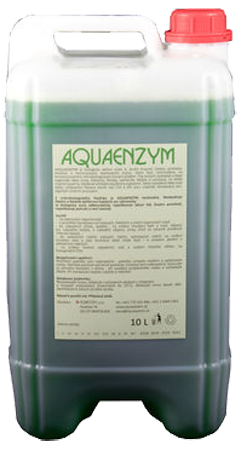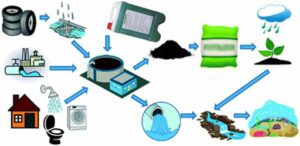Application for drains
DOSAGE DURING PRODUCTION = IMMEDIATELY BINDS IMPURITIES
The most efficient dosing method is dosing directly into the opening of the drainage channel. In this way the separation process is initiated at the very beginning and in this way the whole drainage system is treated.
If the tube ends with an overflow vessel, a certain amount of enzyme is retained and decomposition also occurs at that point.
It is dosed once a day, during the production process when the wastewater drains, depending on the assessment of specific parameters and the conditions at the place of application.
It is necessary to consider the sedimentation of wastewater, the higher the value of chemical oxygen demand (at the beginning of application), the higher the amount of AQUAENZYM.

By using the bio-enzyme agent AQUAENZYM for the treatment of drainage plants, we achieve:
1 In activation tanks :
The added enzymes act as catalysts to accelerate fission reactions as well as to trade substances in the resulting biokinosis. The result of this reaction is a simpler decomposition of complex compounds and fats into simple elements and fatty acids with a small residual carbon (order sizes from 10 to 8). These substances are easily metabolized by a flock of microorganisms. In this way, the fibrous bacteria are suffocated, and the flocks grow to optimal sizes –
“Mostly medium and large.”
Biokenosis has greater resistance to substance overload as well as to hydraulic overload.
STP can also function properly with 20% overload. Foam formation is eliminated, the sedimentation characteristics of activated sludge are improved, and the sludge index is brought to the optimal measure. Sludge stops floating (fibrous bacteria such as MICROTHRIX or NOKARDIA are no longer formed) regeneration and sediment formation are improved. The unpleasant smell disappears.
2 In sludge terminals :
AQUAENZYM will remove the foam, decompose organic substances, the sludge will not float and the emptying of the pipes will be better.
Water is better removed from the sludge and the rest is drier, up to 20% less sludge.
As a result of more perfect decomposition of organic matter, the production of biogas increases, which is also of better quality, by 15 to 20% (depending on the temperature and the amount of organic matter).
3 The values of water from the outlet drain decrease from the maximum load,
which reaches the waste processing plant (CHOD – oxygen for chemical needs, BOD5 – oxygen for biological needs, biological phosphorus, fats) by at least 20%.
 4 Use of flocculants and coagulants
4 Use of flocculants and coagulants
is significantly reduced .
5 Electricity consumption
due to compaction the sludge is reduced .
Low ambient temperatures (frost) or high ambient temperatures slow down the metabolism of flocks of bacteria (bacteria are slow when there is frost, at high temperatures the amount of oxygen decreases), reduce the revitalization of bacteria, create more small flocks, medium and large flocks are present in minimal numbers . This situation results in a worse treatment effect of the processing plant, the sludge starts to get worse characteristics, a strong unpleasant odor can be created, and the values of CHOD, BOD5 at the outlet are high.
1 LITER OF AQUAENZYM APPLIES TO THE EQUIVALENT OF 16,000 INHABITANTS WITH THE AVERAGE VALUE OF CHSK 600 AND BSK5, WHICH HAS A HALF VALUE.

Safety measures and toxicity data of the product
- the product does not contain any compounds that are harmful to humans. It is safe from a microbiological point of view. It does not contain fecal coliform bacteria or salmonella. It is completely biodegradable, it is harmless to the environment, it does not destroy pipelines or fittings, it is not toxic.
Hemijski sastav
- a mixture of enzymes – lipase, amylase, protease and hemicellulose

 063 259 988
063 259 988